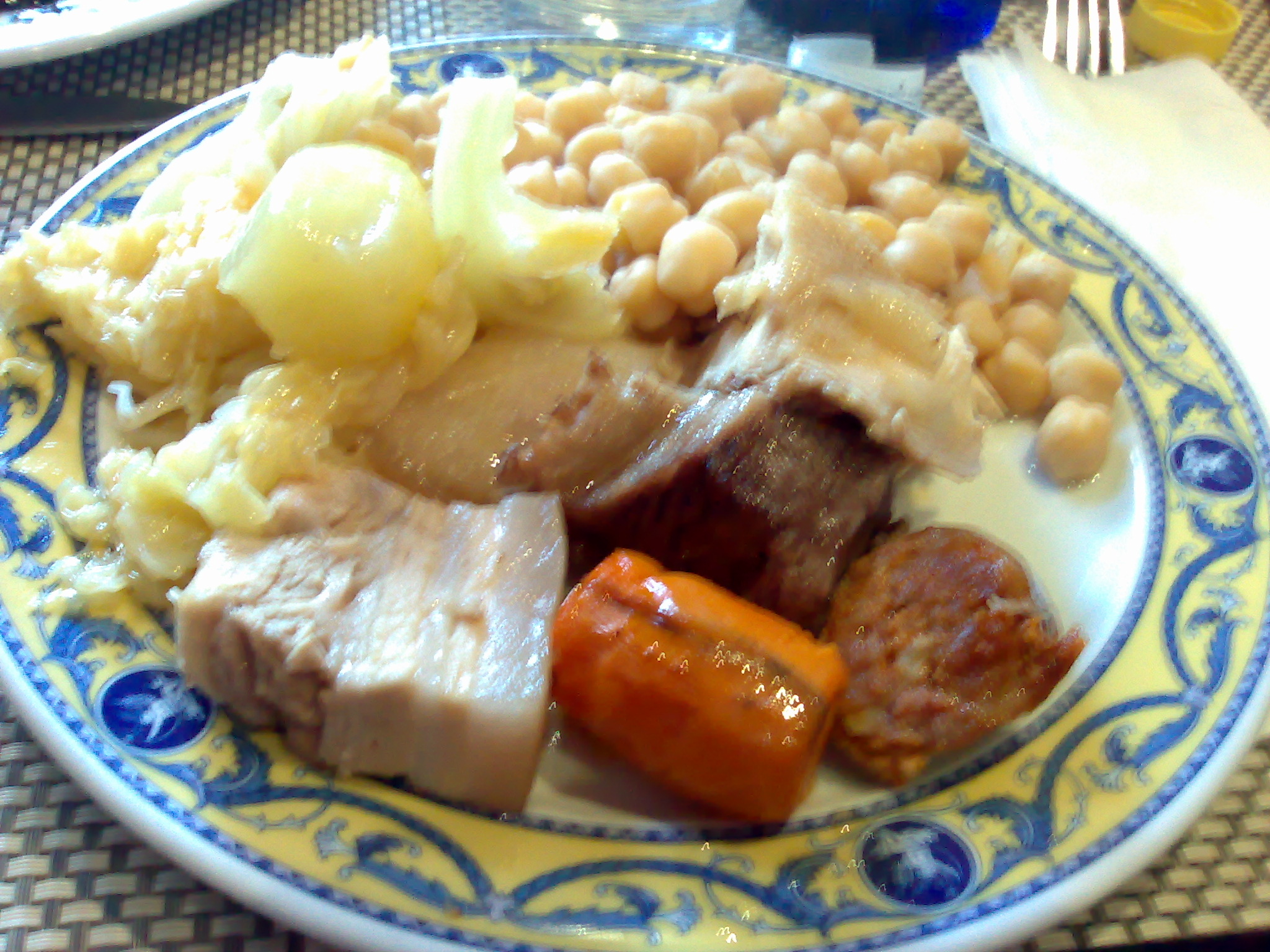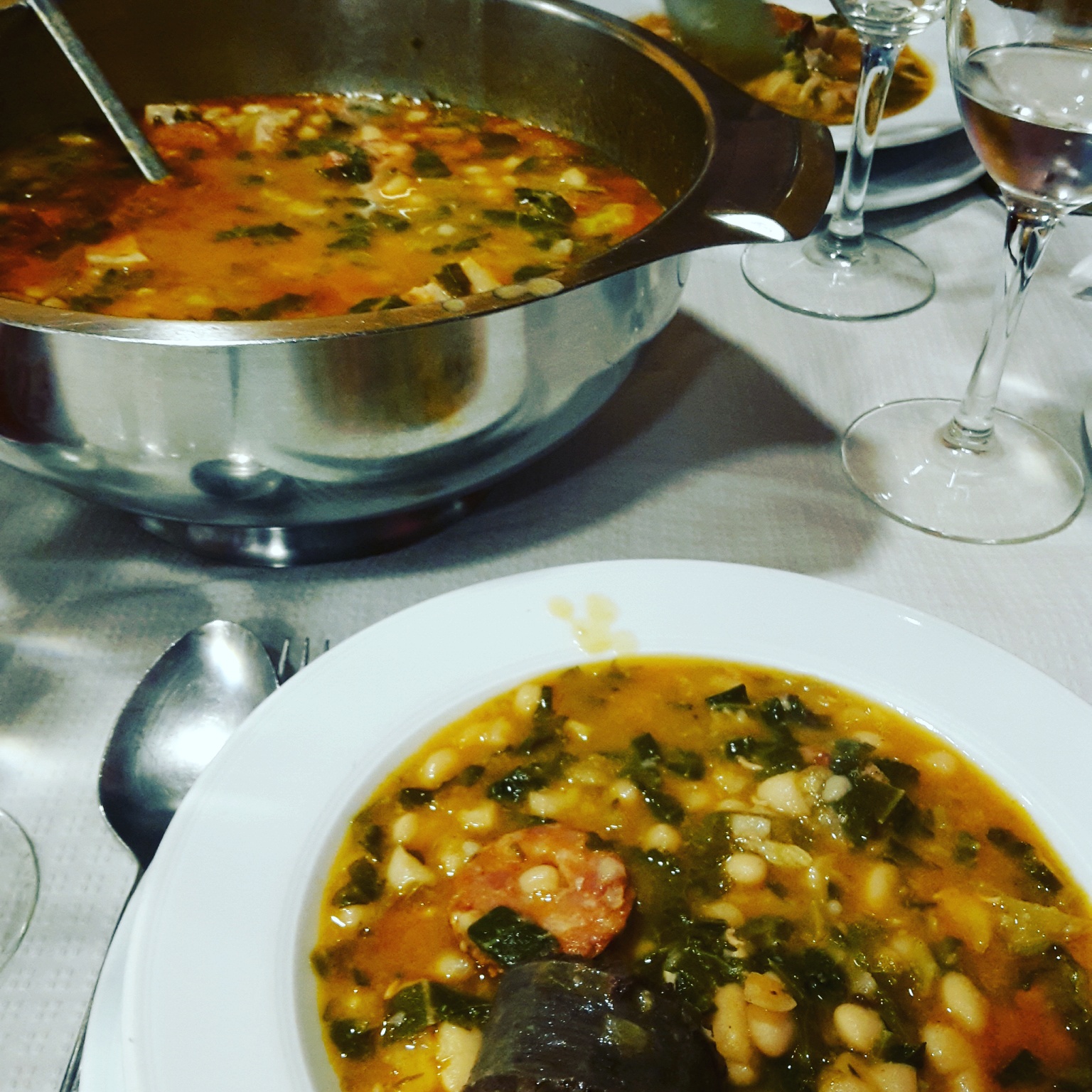|
Cocido
() or ''cozido'' () is a traditional stew eaten as a main dish in Spain, Portugal, Brazil and other Hispanophone and Lusophone countries. Etymology In Spanish, ''cocido'' is the past participle of the verb ''cocer'' ("to boil"), so it literally means "boiled hing. In Portuguese, the word ''cozido'' means "cooked", "boiled" or "baked", being the past participle of the verb ''cozer'' ("to cook", "to boil", or "to bake"). Preparation and ingredients Cocido is made of various meats (pork, beef, chicken, and mutton), embutidos and vegetables like cabbage, turnips, parsnips, potatoes, carrots and chickpeas (''garbanzos''). Other foods (such as eggs or cheese) can be added before serving. Due to the wide regional diversity of the dish, the word ''cocido'' is typically followed by the place of origin (e.g., '' madrileño'', ', '' lebaniego'', '). The basic method of preparation involves slow cooking over low heat. ''Cozido'' may be prepared with a wide variety of v ... [...More Info...] [...Related Items...] OR: [Wikipedia] [Google] [Baidu] |
Cocido Madrileño
(; "Madrilenian stew") is a traditional chickpea-based stew associated with the Madrid region. It is most popular during the winter. Long-cooking ''cocidos'' are thought to be derived from Sephardic adafina recipes. History The origins of the dish are uncertain, but most sources agree that probably it was created during the Middle Ages as an evolution of the Sephardic Jewish dish adafina. Long-cooking dishes were indispensable for Jews as they allowed hearty meals during Shabbat. These first versions were kosher, using eggs and without pork. Societal discrimination against ''conversos'' in early Modern Iberia and the subsequent fear of being denounced as a crypto-Jew favoured the incorporation of pork into meals. Soon lard, bacon, ''chorizo'' (pork sausage) and ''morcilla'' (blood sausage) were added to the dish. From these origins, the recipe allowed few modifications and was soon established as a staple of Madrid cuisine. During the growth of the city in the 19th and 20t ... [...More Info...] [...Related Items...] OR: [Wikipedia] [Google] [Baidu] |
Cocido Montañés
''Cocido montañés'' (translated as 'Mountain stew' or 'Cantabrian stew', depending on context) is a rich hearty Spanish bean stew, originally from and most commonly found in Cantabria in northern Spain. ''Cocido montañés'' is a warm and heavy dish whose origin is the 17th century and it was cooked to fight against the cold and wet climate in the Cantabrian mountains. For that reason it is most commonly eaten during winter and at the largest meal of the day, lunch. The pig is killed during the autumn and preserved to be used during winter. As it is a heavy, high-calorie meal, it is served as a main course. Ingredients ''Cocido montañés'' is made with two vegetable ingredients: dried large white beans (alubia blanca, soaked overnight before use) and collard greens (''berza''). Some recipes use local red bean ''caricu montañés'' instead of white beans or cabbage instead of hard-to-find collard greens. The rest of the elements of this recipe are known as ''compangu'' which ... [...More Info...] [...Related Items...] OR: [Wikipedia] [Google] [Baidu] |
Cocido Lebaniego
Cocido lebaniego is a traditional dish from the region of Liébana in Cantabria, Spain. This stew has some essential ingredients, which include chickpea from the municipality of Potes, potatoes, and collard greens (nowadays cabbage is sometimes substituted for the collard greens). The rest of the elements of this recipe are known as ''compangu'', which refers to meat from the pig slaughter, such as bacon ('' tocino''), black pudding (''morcilla''), chorizo, and ham. Another additional ingredient is beef, especially cecina, bones and a stuffing made of bread flour, eggs, chorizo, and parsley. Characteristics This dish is very rich and has great nutritional value. Therefore, it is eaten as a main dish. The soup is eaten first, then the chickpeas (occasionally with lettuce) and finally the meat with the stuffing, although sometimes the chickpeas and meat are served together. See also *List of stews * ''Cocido madrileño'' * ''Cocido montañés'' * ''Cozido à portuguesa () or P ... [...More Info...] [...Related Items...] OR: [Wikipedia] [Google] [Baidu] |
Cozido à Portuguesa
() or Portuguese stew is a type of '' cozido'', traditional Portuguese boiled meal. Numerous regional variations exist throughout Portugal, and the dish is considered part of the Portuguese heritage, as well as one of the national dishes of Portugal. Preparation and ingredients ''Cozido à Portuguesa'' is prepared with a multitude of vegetables (cabbages, beans, potatoes, carrots, turnips, rice), meat (chicken, pork ribs, bacon, pork ear and trotters, various parts of beef), and smoked sausages (chouriço, farinheira, morcela), among others. In the São Miguel Island, Azores The Azores ( , , ; , ), officially the Autonomous Region of the Azores (), is one of the two autonomous regions of Portugal (along with Madeira). It is an archipelago composed of nine volcanic islands in the Macaronesia region of the North Atl ..., a local version of the Cozido à Portuguesa is cooked underground with heat and steam coming from the volcanic phenomena in the area. See also * ... [...More Info...] [...Related Items...] OR: [Wikipedia] [Google] [Baidu] |
Stew
A stew is a combination of solid food ingredients that have been Cooking, cooked in Soup, liquid and served in the resultant gravy. Ingredients can include any combination of vegetables and may include meat, especially tougher meats suitable for slow-cooking, such as beef, pork, venison, Rabbit as food, rabbit, lamb and mutton, lamb, poultry, sausages, and seafood. While water can be used as the stew-cooking liquid, Stock (food), stock is also common. A small amount of red wine or other alcohol is sometimes added for flavour. Seasonings and flavourings may also be added. Stews are typically cooked at a relatively low temperature (Simmering, simmered, not Boiling, boiled), allowing flavours to mingle. Stewing is suitable for the least tender cuts of meat that become tender and juicy with the slow, moist heat method. This makes it popular for low-cost cooking. Cuts with a certain amount of marbling and gelatinous connective tissue give moist, juicy stews, while lean meat may easily ... [...More Info...] [...Related Items...] OR: [Wikipedia] [Google] [Baidu] |
Turnip
The turnip or white turnip ('' Brassica rapa'' subsp. ''rapa'') is a root vegetable commonly grown in temperate climates worldwide for its white, fleshy taproot. Small, tender varieties are grown for human consumption, while larger varieties are grown as feed for livestock. The name ''turnip'' used in many regions may also be used to refer to rutabaga (or ''neep'' or ''swede''), which is a different but related vegetable. Etymology The origin of the word ''turnip'' is uncertain, though it is hypothesised that it could be a compound of ''turn'' as in turned/rounded on a lathe and ''neep'', derived from Latin ''napus'', the word for the plant. According to An Universal Etymological English Dictionary, ''turn'' refers to "round ''napus'' to distinguish it from the napi, which were generally long". Description The most common type of turnip is mostly white-skinned, apart from the upper , which protrude above the ground and are purple or red or greenish where the sun has h ... [...More Info...] [...Related Items...] OR: [Wikipedia] [Google] [Baidu] |
Embutido
(Spanish and Brazilian Portuguese), (European Portuguese) or (Catalan) is a generic term for cured ground meat products. The dictionary of the Royal Spanish Academy defines it as "intestine stuffed with minced meat, mainly pork; intestine stuffed with diverse ingredients" Illustrating use of "embutido" for all sorts of sausages, fresh and dried, including frankfurters (the Spanish word comes from the verb ''embutir'', meaning 'to stuff'). The term often applies to any of the many varieties of cured, dry sausages found in the cuisines of Iberia and the former Spanish and Portuguese colonies. In Philippine cuisine, however, due to the fusion of Spanish and American cuisine in the islands, embutido (or embotido) refers to a type of meatloaf wrapped around slices of egg and sausage. Varieties Specific varieties include, among many others (see list of sausages for the various countries): * Chorizo/chouriço * Sobrassada from the Balearic Islands * Botifarra from Catalonia * ... [...More Info...] [...Related Items...] OR: [Wikipedia] [Google] [Baidu] |
Vegetable
Vegetables are edible parts of plants that are consumed by humans or other animals as food. This original meaning is still commonly used, and is applied to plants collectively to refer to all edible plant matter, including edible flower, flowers, fruits, edible plant stem, stems, leaf vegetable, leaves, list of root vegetables, roots, and list of edible seeds, seeds. An alternative definition is applied somewhat arbitrarily, often by culinary and cultural tradition; it may include savoury fruits such as tomatoes and courgettes, flowers such as broccoli, and seeds such as Pulse (legume), pulses, but exclude foods derived from some plants that are fruits, flowers, nut (fruit), nuts, and cereal grains. Originally, vegetables were collected from the wild by hunter-gatherers and entered cultivation in several parts of the world, probably during the period 10,000 BC to 7,000 BC, when a new History of agriculture, agricultural way of life developed. At first, plants that g ... [...More Info...] [...Related Items...] OR: [Wikipedia] [Google] [Baidu] |
Cabbage
Cabbage, comprising several cultivars of '' Brassica oleracea'', is a leafy green, red (purple), or white (pale green) biennial plant grown as an annual vegetable crop for its dense-leaved heads. It is descended from the wild cabbage ( ''B. oleracea'' var. ''oleracea''), and belongs to the " cole crops" or brassicas, meaning it is closely related to broccoli and cauliflower (var. ''botrytis''); Brussels sprouts (var. ''gemmifera''); and Savoy cabbage (var. ''sabauda''). A cabbage generally weighs between . Smooth-leafed, firm-headed green cabbages are the most common, with smooth-leafed purple cabbages and crinkle-leafed savoy cabbages of both colours being rarer. Under conditions of long sunny days, such as those found at high northern latitudes in summer, cabbages can grow quite large. , the heaviest cabbage was . Cabbage heads are generally picked during the first year of the plant's life cycle, but plants intended for seed are allowed to grow a second year and m ... [...More Info...] [...Related Items...] OR: [Wikipedia] [Google] [Baidu] |
Egg As Food
Humans and other hominids have consumed eggs for millions of years. The most widely consumed eggs are those of fowl, especially chickens. People in Southeast Asia began harvesting chicken eggs for food by 1500 BCE. Eggs of other birds, such as ducks and ostriches, are eaten regularly but much less commonly than those of chickens. People may also eat the eggs of reptiles, amphibians, and fish. Fish eggs consumed as food are known as roe or caviar. Hens and other egg-laying creatures are raised throughout the world, and mass production of chicken eggs is a global industry. In 2009, an estimated 62.1 million metric tons of eggs were produced worldwide from a total laying flock of approximately 6.4 billion hens. There are issues of regional variation in demand and expectation, as well as current debates concerning methods of mass production. In 2012, the European Union banned battery husbandry of chickens. History Bird eggs have been valuable foodstuffs since prehistor ... [...More Info...] [...Related Items...] OR: [Wikipedia] [Google] [Baidu] |




